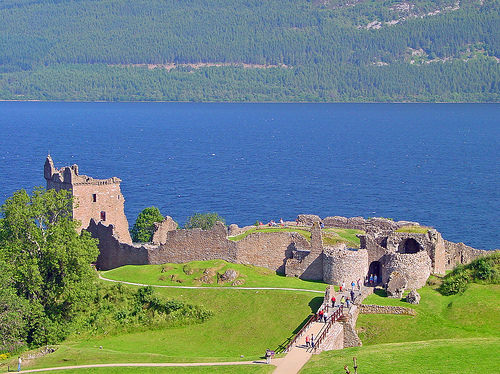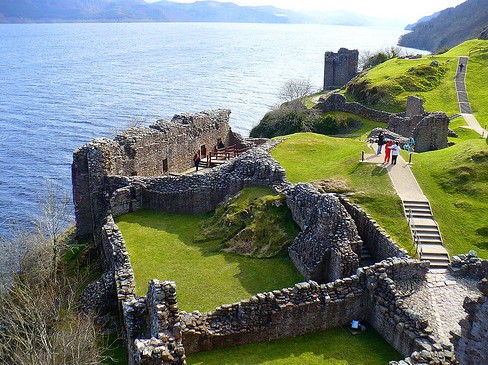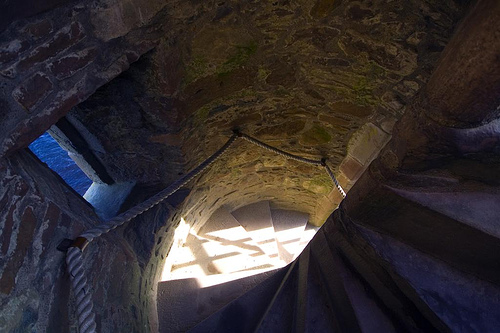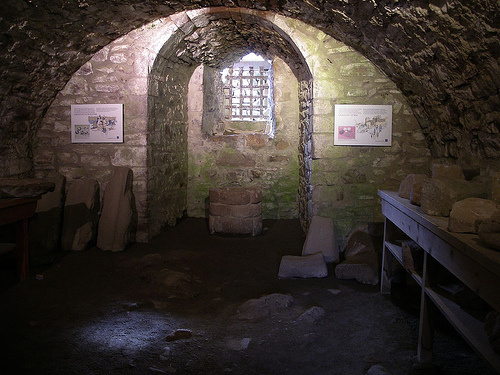

Location: Scotland Map
Open: 1 Apr- 30 Sept 9:30am- 6pm
1 Oct- 31 Oct 9:30am- 5pm
1 Nov- 31 Mar 9:30 am- 4:30pm
Tel: 01456 450551

Urquhart Castle is one of the largest and most important medieval castles in Scotland. Urquhart Castle stands on the shore of the Loch Ness Lake close to a village of Drumnadrochit along A82 road. Despite it present poor condition it is still one of the most visited sites in Scotland. This interest lies partially in the castle itself and partially due to numerous sightings of the legendary Nessie that said to inhabit the lake of Loch Ness. This location was used for defensive purposed for the past 4000 years. Unfortunately little information is known from the first hand accounts. The last citadel build here was no later than early 13th century. English kings Edward I captured this castle in 1296 during his campaign against the Scots of the Highlands. The castle changed several times in the course of its history. Unfortunately it was blown up in 1692 by Williamite troops to prevent rebellious Scottish Jacobite forces to use it as their stronghold. The remains of whole portions of walls are still littering of what used to be one of the best defended castles in the region.

The first traces of settlement in the area date back
to before Saint Columban's visit in the 6th century. In Adomnán's Life
of Columba, a forerunner of the fortress is mentioned as the residence
of a Pictish nobleman. Artifacts have been found on the site during
various excavations, but an earlier suspected Pictish fort has not yet
been proven.
The castle through the ages
By 1230, King
Alexander II had put down a revolt against his rule in the Moray region.
To secure his reign, he gave this region to his son-in-law Alan Durward.
He began immediately with the construction of a strategically located
castle complex, which was planned as a fortress. Nevertheless, the
complex was to have all the comforts of a residence expected of a chief
of Clan Urquhart. This castle was one of the largest in Scotland in its
heyday. The stone ring wall surrounded an extensive area and thus
protected the wooden residential buildings inside.
In 1275 Alan
Durward died without heirs and the castle passed to the Comyn family. In
1296 it was taken by the English, in 1303 it was recaptured by the
Scots, but fell back into English hands in the same year. After becoming
king, Robert the Bruce was able to finally bring the site under Scottish
control in 1306. After that, the complex gained more and more strategic
importance and from 1395 it was further expanded into a medieval
fortress. For example, the heavily fortified gatehouse and the keep were
added as a second point of defense to the north of the complex. However,
over the next 150 years many of the erected structures were badly
damaged when the Clan MacDonald 'Lords of the Isles' opposed the Crown.
The northern part of the castle was strengthened as it was easier to
defend a smaller compound with few people.
From 1545 the castle
was largely abandoned as a defensive structure, and instead the keep was
renovated and converted into a residential building for a laird. By this
time, part of the defenses had already fallen into disrepair.
By
1600 the castle was deserted as the lairds now preferred more
comfortable residences in more acceptable areas. As a result, the castle
no longer played a strategic role, the last garrison left it after the
Scottish Jacobite Rising of 1689 in 1692. From then on, the castle was
left to decay. After it was abandoned, the buildings were systematically
looted; their stones and roofs were partially removed for the
construction of houses. 10 tons of lead stolen from the roof
construction of the plant alone were found in the surrounding cottages
and barns.

You approach the castle from the west across a gently sloping meadow.
The former drawbridge A (now a fixed structure) spans a ditch up to 30
meters wide and up to 5 meters deep. The castle is entered through
Gatehouse B, a passage protected by two round towers. These towers
formerly contained the guardrooms, a prison cell and the mechanisms for
raising and lowering the drawbridge.
If you turn right after
entering the castle, you reach the upper bailey, the upper courtyard J.
This is the oldest part of the complex and at the same time the part
lying highest on the rock, this is also where most Celtic artefacts were
found during excavations. Only ruins of the foundations are evidence of
the former buildings K; the use of most of these rooms has not been
clearly determined to this day. However, a round foundation L can be
identified as a brick pigeon tower, another area M has been identified
as a smithy. The transition between the upper and lower courtyard is
formed by Water Gate I, located opposite the gatehouse, with access to
Loch Ness.
The nether bailey, the lower courtyard C, gives access
to the other buildings of the castle, which were built later and are
better preserved in large parts. However, the courtyard is dominated by
a small hill on which the foundations of a former chapel D can be found.
On the right are the remains of the "Great Hall" G and H, where the
kitchen and accommodation for the lord of the castle and his guests were
also to be found.
The best-preserved part of the castle has also
been in use the longest, and is sometimes called the citadel in English
and sometimes in German. It consists of a small gatehouse with
additional rooms of unknown purpose E and the keep-like tower house F.
Its massive foundation dates from the 14th century, the floors above
were only built after 1509.
Protected by another small moat, you
enter this tower on its first floor, which once contained a single large
hall. The cellar vaults below could only be reached from here. Living
and sleeping quarters were found on the two floors above, including the
private room of the lord of the castle. Big chimneys and small latrines
offered a certain comfort. The top floor was designed for military
purposes, with guardrooms and sleeping quarters for the soldiers, as
well as some defensive oriels.
Around 1930 a Mr. Chewett bought the ruins, today the castle belongs to the National Trust for Scotland and is managed by Historic Scotland. Urquhart Castle is a popular part of Scotland tours, and the ruins are correspondingly well visited. The facility includes a bus parking lot and a large visitor center which, in addition to a small museum, also has a large souvenir shop, an information cinema and a café. The facility is open all year round. In 2019, Urquhart Castle was visited by around 548,000 people. The ruin is located directly on the A82 and is also served by regular buses.